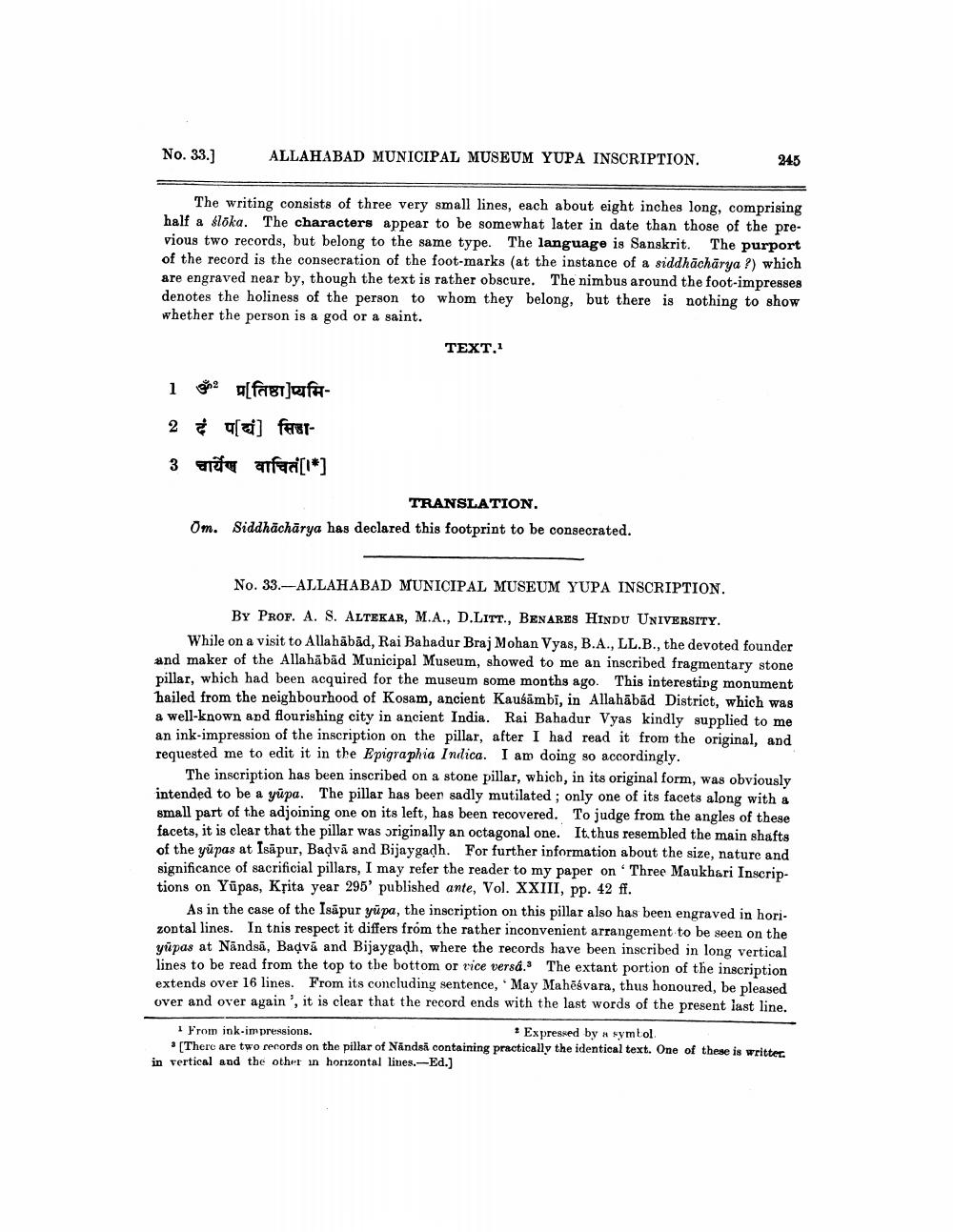________________
No. 33.]
ALLAHABAD MUNICIPAL MUSEUM YUPA INSCRIPTION.
245
The writing consists of three very small lines, each about eight inches long, comprising half a bloka. The characters appear to be somewhat later in date than those of the previous two records, but belong to the same type. The language is Sanskrit. The purport of the record is the consecration of the foot-marks (at the instance of a siddhāchārya ?) which are engraved near by, though the text is rather obscure. The nimbus around the foot-impresses denotes the holiness of the person to whom they belong, but there is nothing to show whether the person is a god or a saint.
TEXT.
1 sv2 [
ft]of 2 [a] fer3 te afrai[l*]
TRANSLATION. Om. Siddhāchārya has declared this footprint to be consecrated.
No. 33.--ALLAHABAD MUNICIPAL MUSEUM YUPA INSCRIPTION.
By Prof. A. S. ALTEKAR, M.A., D.LITT., BENARES HINDU UNIVERSITY, While on a visit to Allahābād, Rai Bahadur Braj Mohan Vyas, B.A., LL.B., the devoted founder and maker of the Allahābād Municipal Museum, showed to me an inscribed fragmentary stone pillar, which had been acquired for the museum some months ago. This interesting monument hailed from the neighbourhood of Kosam, ancient Kausambi, in Allahābād District, which was a well-known and flourishing city in ancient India. Rai Bahadur Vyas kindly supplied to me an ink-impression of the inscription on the pillar, after I had read it from the original, and requested me to edit it in the Epigraphia Indica. I am doing so accordingly.
The inscription has been inscribed on a stone pillar, which, in its original form, was obviously intended to be a yüpa. The pillar has been sadly mutilated; only one of its facets along with a small part of the adjoining one on its left, has been recovered. To judge from the angles of these facets, it is clear that the pillar was originally an octagonal one. It thus resembled the main shafts of the yūpas at Isäpur, Badvā and Bijaygadh. For further information about the size, nature and significance of sacrificial pillars, I may refer the reader to my paper on Three Maukhari Inscriptions on Yüpas, Krita year 295' published ante, Vol. XXIII, pp. 42 ff.
As in the case of the Isāpur yüpa, the inscription on this pillar also has been engraved in hori. zontal lines. In this respect it differs from the rather inconvenient arrangement to be seen on the yüpas at Nändsă, Badvă and Bijaygadh, where the records have been inscribed in long vertical lines to be read from the top to the bottom or rice versa. The extant portion of the inscription extends over 16 lines. From its concluding sentence, May Mahēšvara, thus honoured, be pleased over and over again, it is clear that the record ends with the last words of the present last line.
From ink-impressions.
Expressed by a symbol • There are two records on the pillar of Nåndsi containing practically the identical text. One of these is writter in vertical and the other in horizontal lines.-Ed.)




